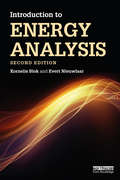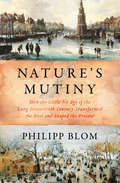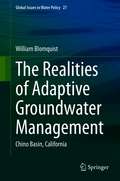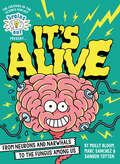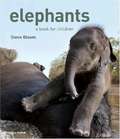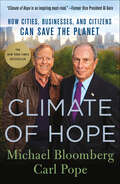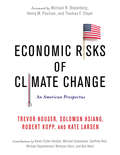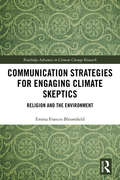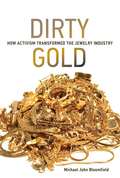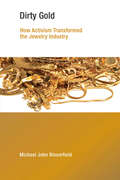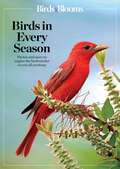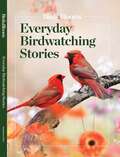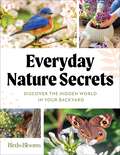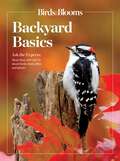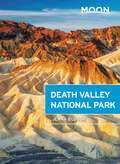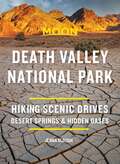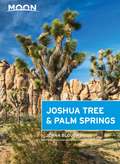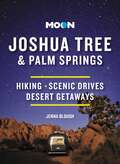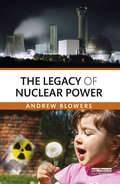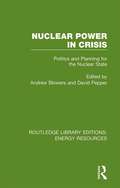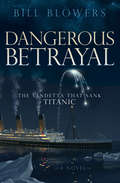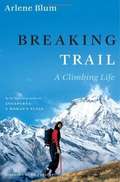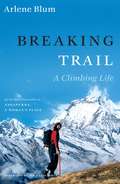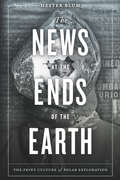- Table View
- List View
Introduction to Energy Analysis
by Kornelis Blok Evert NieuwlaarThe energy supply and demand system is of great importance for society, from economic, social, and ecological viewpoints. The last decade in particular has seen rapid changes in the world of energy systems, and it is therefore now an important area for study, academic research, and professional work. This textbook provides an introduction to energy analysis for those students who want to specialise in this challenging field. In comparison to other textbooks, this book provides a balanced treatment of complete energy systems, covering the demand side, the supply side, and the energy markets that connect these. The emphasis is very much on presenting a range of tools and methodologies that will help students find their way in analysing real world problems in energy systems. Featuring learning objectives, further readings and practical exercises in each chapter, An Introduction to Energy Analysis will be essential reading for upper-level undergraduate and postgraduate students with a background in the natural sciences and egineering. This book may also be useful for professionals dealing with energy issues, as a first introduction into the field.
Nature's Mutiny: How The Little Ice Age Of The Long Seventeenth Century Transformed The West And Shaped The Present
by Philipp BlomAn illuminating work of environmental history that chronicles the great climate crisis of the 1600s, which transformed the social and political fabric of Europe. <P><P> Although hints of a crisis appeared as early as the 1570s, the temperature by the end of the sixteenth century plummeted so drastically that Mediterranean harbors were covered with ice, birds literally dropped out of the sky, and “frost fairs” were erected on a frozen Thames—with kiosks, taverns, and even brothels that become a semi-permanent part of the city. <P><P> Recounting the deep legacy and far-ranging consequences of this “Little Ice Age,” acclaimed historian Philipp Blom reveals how the European landscape had suddenly, but ineradicably, changed by the mid-seventeenth century. While apocalyptic weather patterns destroyed entire harvests and incited mass migrations, they gave rise to the growth of European cities, the emergence of early capitalism, and the vigorous stirrings of the Enlightenment. A timely examination of how a society responds to profound and unexpected change, Nature’s Mutiny will transform the way we think about climate change in the twenty-first century and beyond.
The Realities of Adaptive Groundwater Management: Chino Basin, California (Global Issues in Water Policy #27)
by William BlomquistThis book has three primary objectives. The first objective is to provide scholars with a more realistic view of adaptive management, without arguing against adaptive management. Adaptive management is necessary as well as desirable, but it is not easy, and demonstrating that through the Chino Basin experience is an important goal. The second objective is to provide practitioners with encouraging yet cautionary lessons about the challenges and benefits of an adaptive approach – in similar fashion as the first objective, the goal here is to endorse the adaptive approach but in a clear-eyed manner that clarifies how hard it is and how much it requires. A third objective is to show all audiences that resource governance systems can fail, change, and succeed. There is no such thing as an ideal institutional design that is guaranteed to work; rather, making institutional arrangements work entails learning and adjustment when they begin to show problems as they inevitably will.
Brains On! Presents...It's Alive: From Neurons and Narwhals to the Fungus Among Us
by Molly Bloom Marc Sanchez Sanden TottenThe creators of the award-winning science podcast for kids, Brains On!, present a humorous, highly illustrated, fact- and fun-filled look at life on Earth— from deep sea creatures and carnivorous plants to the human body and stinky bacteria. Perfect for STEM collections! Did you ever wonder why jellyfish sting? Or if trees communicate with each other? How about why you can't tickle yourself?Well hold on to your noggins, because you're about to find out! Join the creators of the award-winning science podcast Brains On! as they explore the uber-awesome and sometimes gross world of biology—aka the study of living things. Inside these pages, you'll meet animals with superpowers, plants that eat meat, brains that trick you, and tiny microbes that live, well . . . all over you!Packed with mind-boggling facts and laugh-out-loud jokes, this book promises a brain-bending, jaw-dropping, belly-laughing good time as readers watch the world around them come ALIVE.
Elephants: A Book For Children
by Steve Bloom David Henry WilsonFrom Babar to Dumbo, the elephant has long fascinated children as well as their parents. Here, eighty stunning photographs encompass every aspect of the elephant's life and world: elephants big and small, African and Asian, in the wild and domesticated, at play and at rest. Whether taken from the air, from underwater, or from the side of a jeep, these images will capture the imagination of any child. Steve Bloom's extraordinary photographs depict the elephants in their natural environment as well as in their unique relationships with people. Here are elephant babies playing in the dust, families rolling in the mud, polo-playing elephants, elephants at bath time, impressive herds roaming the plains, and much more. The entertaining texts by David Henry Wilson explain anything and everything of interest about elephants, from why they flap their ears to how much they weigh and how much they eat.
Climate of Hope: How Cities, Businesses, and Citizens Can Save the Planet
by Michael Bloomberg Carl PopeNEW YORK TIMES BESTSELLERFrom Mayor Michael Bloomberg and former head of the Sierra Club Carl Pope comes a manifesto on how the benefits of taking action on climate change are concrete, immediate, and immense. They explore climate change solutions that will make the world healthier and more prosperous, aiming to begin a new type of conversation on the issue that will spur bolder action by cities, businesses, and citizens—and even, someday, by Washington."Climate of Hope is an inspiring must read." —Former Vice President Al Gore, Chairman of The Climate Reality Project“Climate change threatens to reshape the future of our world's population centers. Bloomberg and Pope have been leaders on fortifying our cities against this threat, and their book proves that victory is possible—and imperative.” —Leonardo DiCaprio"If Trump is looking for a blueprint, he could not do better than to read a smart new book, Climate of Hope." —Thomas Friedman in The New York Times~The 2016 election left many people who are concerned about the environment fearful that progress on climate change would come screeching to a halt. But not Michael Bloomberg and Carl Pope. Bloomberg, an entrepreneur and former mayor of New York City, and Pope, a lifelong environmental leader, approach climate change from different perspectives, yet they arrive at similar conclusions. Without agreeing on every point, they share a belief that cities, businesses, and citizens can lead—and win—the battle against climate change, no matter which way the political winds in Washington may shift. In Climate of Hope, Bloomberg and Pope offer an optimistic look at the challenge of climate change, the solutions they believe hold the greatest promise, and the practical steps that are necessary to achieve them. Writing from their own experiences, and sharing their own stories from government, business, and advocacy, Bloomberg and Pope provide a road map for tackling the most complicated challenge the world has ever faced. Along the way, they turn the usual way of thinking about climate change on its head: from top down to bottom up, from partisan to pragmatic, from costs to benefits, from tomorrow to today, and from fear to hope.
Economic Risks of Climate Change
by Michael R. Bloomberg Solomon Hsiang Robert Kopp Trevor Houser Kate LarsenClimate change threatens the economy of the United States through increased flooding and storm damage, climate-driven changes in crop yields, disruptions in labor productivity, crime, and public health and heat-related strains on energy systems. Combining current data with state-of-the-art climate models, econometric research on human responses to climate, and cutting-edge private sector risk assessment tools, this prospectus crafts a game-changing analysis of the risks of future climate change in specific U.S. regions and sectors.This work is based on a critically acclaimed independent assessment of climate change's economic risks commissioned by the Risky Business Project. With contributions from Karen Fisher-Vanden (Penn State University), Michael Greenstone (MIT), Geoffrey Heal (Columbia Business School), Michael Oppenheimer (Princeton University), and Nicholas Stern and Bob Ward (Grantham Research Institute), as well as a foreword from the nation's leading voices on environmental action, the prospectus speaks to scientists, researchers, scholars, activists, and policymakers. It depicts the distribution of escalating climate change risk across the country and anticipates its effects on aspects as varied as coastal property and crime. Beautifully illustrated and accessibly written, Economic Risks of Climate Change is an essential tool for helping businesses and governments prepare for the future.
Communication Strategies for Engaging Climate Skeptics: Religion and the Environment (Routledge Advances in Climate Change Research)
by Emma Frances BloomfieldCommunication Strategies for Engaging Climate Skeptics examines the intersection of climate skepticism and Christianity and proposes strategies for engaging climate skeptics in productive conversations. Despite the scientifically established threats of climate change, there remains a segment of the American population that is skeptical of the scientific consensus on climate change and the urgent need for action. One of the most important stakeholders and conversants in environmental conversations is the religious community. While existing studies have discussed environmentalism as a factor within the religious community, this book positions religion as an important factor in environmentalism and focuses on how identities play a role in environmental conversation. Rather than thinking of religious skeptics as a single unified group, Emma Frances Bloomfield argues that it is essential to recognize there are different types of skeptics so that we can better tailor our communication strategies to engage with them on issues of the environment and climate change. To do so, this work breaks skeptics down into three main types: "separators," "bargainers," and "harmonizers." The book questions monolithic understandings of climate skepticism and considers how competing narratives such as religion, economics, and politics play a large role in climate communication. Considering recent political moves to remove climate change from official records and withdraw from international environmental agreements, it is imperative now more than ever to offer practical solutions to academics, practitioners, and the public to change the conversation. To address these concerns, this book provides both a theoretical examination of the rhetoric of religious climate skeptics and concrete strategies for engaging the religious community in conversations about the environment. This book will be of great interest to students, scholars, and practitioners of climate change science, environmental communication, environmental policy, and religion.
Dirty Gold: How Activism Transformed the Jewelry Industry
by Michael John BloomfieldGold mining can be a dirty business. It creates immense amounts of toxic materials that are difficult to dispose of. Mines are often developed without community consent, and working conditions for miners can be poor. Income from gold has funded wars. And consumers buy wedding rings and gold chains not knowing about any of this. In Dirty Gold, Michael Bloomfield shows what happened when Earthworks, a small Washington-based NGO, launched a campaign for ethically sourced gold in the consumer jewelry market, targeting Tiffany and other major firms. The unfolding of the campaign and its effect on the jewelry industry offer a lesson in the growing influence of business in global environmental politics. Earthworks planned a "shame" campaign, aimed at the companies' brands and reputations, betting that firms like Tiffany would not want to be associated with pollution, violence, and exploitation. As it happened, Tiffany contacted Earthworks before they could launch the campaign; the company was already looking for partners in finding ethically sourced gold.Bloomfield examines the responses of three companies to "No Dirty Gold" activism: Tiffany, Wal-Mart, and Brilliant Earth, a small company selling ethical jewelry. He finds they offer a case study in how firms respond to activist pressure and what happens when businesses participate in such private governance schemes as the "Golden Rules" and the "Conflict-Free Gold Standard." Taking a firm-level view, Bloomfield examines the different opportunities for and constraints on corporate political mobilization within the industry.
Dirty Gold: How Activism Transformed the Jewelry Industry (Earth System Governance)
by Michael John BloomfieldThe response from the jewelry industry to a campaign for ethically sourced gold as a case study in the power of business in global environmental politics.Gold mining can be a dirty business. It creates immense amounts of toxic materials that are difficult to dispose of. Mines are often developed without community consent, and working conditions for miners can be poor. Income from gold has funded wars. And consumers buy wedding rings and gold chains not knowing about any of this. In Dirty Gold, Michael Bloomfield shows what happened when Earthworks, a small Washington-based NGO, launched a campaign for ethically sourced gold in the consumer jewelry market, targeting Tiffany and other major firms. The unfolding of the campaign and its effect on the jewelry industry offer a lesson in the growing influence of business in global environmental politics. Earthworks planned a “shame” campaign, aimed at the companies' brands and reputations, betting that firms like Tiffany would not want to be associated with pollution, violence, and exploitation. As it happened, Tiffany contacted Earthworks before they could launch the campaign; the company was already looking for partners in finding ethically sourced gold.Bloomfield examines the responses of three companies to “No Dirty Gold” activism: Tiffany, Wal-Mart, and Brilliant Earth, a small company selling ethical jewelry. He finds they offer a case study in how firms respond to activist pressure and what happens when businesses participate in such private governance schemes as the “Golden Rules” and the “Conflict-Free Gold Standard.” Taking a firm-level view, Bloomfield examines the different opportunities for and constraints on corporate political mobilization within the industry.
Birds & Blooms Birds in Every Season: Cherish the Feathered Flyers in Your Yard All Year Long
by Birds BloomsReader-submitted stories and photos from Birds & Blooms magazine highlight the beauty of birds in every season and from a variety of habitats in this all-new collection. More than 300 brilliant photos, stories from today&’s birders, photography tips, and hints and ideas for attracting birds to your yard round out this keepsake book.Go birdwatching without leaving the house as you page through Birds in Every Season. Incredible nature photography makes this a coffee-table book you&’ll reach for time and again, and reader-submitted stories, hints and tips offer insight into the rewarding hobby of birding. Created by the pros at Birds & Blooms magazine, this keepsake highlights the beauty of birds in a variety of habitats around the country, from brightly colored warblers and elegant egrets to stoic-looking owls and tiny finches. Enjoy photos and tales from fellow bird lovers about their encounters with these feathered friends, and learn tips and tricks for successful seasonal birding in special sections at the end of each chapter.
Birds & Blooms Everyday Birdwatching Stories
by Birds BloomsMore than 300 stunning photos of birds throughout the United States, paired with reader stories about each encounter along with interesting factual tidbits and special sections that detail how to attract birds to your backyard.Every birder who ventures into the outdoors with a camera comes back with more than just photos: they return with stories to tell. In Everyday Birdwatching Stories, the editors of Birds & Blooms magazine gather stunning images of your favorite fluttery backyard visitors paired with heartwarming stories about how each snapshot was captured. Inside, you&’ll find: More than 300 photos of beloved birds in summer, spring, winter and fall, with the photographers&’ inspiring stories about how they found each bird. Factual tidbits in every chapter about birdsongs, species names and more Articles that explain how to attract a variety of birds to your backyard Whether you&’re an avid birdwatcher and photographer or an armchair avian enthusiast, Everyday Birdwatching Stories offers plenty to marvel at and learn—and brings you close to a world of wonderful wings.
Birds & Blooms Everyday Nature Secrets
by Birds BloomsA Simon & Schuster eBook. Simon & Schuster has a great book for every reader.
Birds and Blooms Backyard Basics
by Birds And BloomsA Simon & Schuster eBook. Simon & Schuster has a great book for every reader.
Deepwater Horizon
by James M. Blossom Earl BoebertIn 2010 BP's Deepwater Horizon catastrophe spiraled into the worst human-made economic and ecological disaster in Gulf Coast history. In the most comprehensive account to date, senior systems engineers Earl Boebert and James Blossom show how corporate and engineering decisions, each one individually innocuous, interacted to create the disaster.
Moon Death Valley National Park (Travel Guide)
by Jenna BloughTrek across the salt flats, scale the towering rocks, and explore the marble canyons of this otherworldly landscape with Moon Death Valley National Park. Inside you'll find:Flexible, strategic itineraries, ranging from one day in the park to a week-long trip, designed for day-hikers, road-trippers, outdoor adventurers, history buffs, and moreThe top experiences and unique ideas for exploring Death Valley: Hike through forested trails to sweeping canyon views, and discover abandoned mining camps, remote ghost towns, and hidden springs. Go four-wheeling in rugged backcountry, or cruise along Badwater Basin Road to check out iconic sights like the Devil's Golf Course, Artist's Drive, and Zabriskie Point. Admire surreal salt flats, ethereal rock formations, colorful mosaic stone, and sculpted sand dunes, and find the best vistas for that perfect sunset photo-opPractical tips for hiking, four-wheel driving, camping, and other recreation, plus information on the right gear to pack for the desert Detailed hike descriptions with mileage, elevation gains, difficulty ratings, and trailhead directionsHonest advice from Death Valley expert Jenna Blough on when to go and where to stay, whether you're pitching the tent, parking the RV, or bedding down at a hotel Up-to-date information on park fees, passes, and reservations, plus strategies for getting to Death Valley National ParkFull-color photos and detailed maps throughoutCoverage of gateway towns and excursions beyond the park, including the John Muir Wilderness, the Ash Meadows National Wildlife Refuge, and the Trona PinnaclesRecommendations for families, seniors, international visitors, and travelers with disabilitiesThorough background on Death Valley's wildlife, terrain, culture, and historyWith Moon's practical tips and expert know-how, you can experience Death Valley your way.Exploring more of the West? Try Moon California Road Trip, Moon Palm Springs & Joshua Tree or Moon Nevada.For full coverage of America's national parks, check out Moon USA National Parks: The Complete Guide to All 59 National Parks.Special ebook features:Easily navigate listings with quick searches, plus website links and zoom-in maps and imagesPersonalize your guide by adding notes and bookmarks
Moon Death Valley National Park: Hiking, Scenic Drives, Desert Springs & Hidden Oases (Travel Guide)
by Jenna BloughTrek across the salt flats, scale the towering rocks, and explore the marble canyons of this otherworldly landscape with Moon Death Valley National Park. Inside you'll find:Flexible, strategic itineraries, ranging from one day in the park to a week-long trip, designed for day-hikers, road-trippers, outdoor adventurers, history buffs, and moreThe top experiences and unique ideas for exploring Death Valley: Hike through forested trails to sweeping canyon views, and discover abandoned mining camps, remote ghost towns, and hidden springs. Go four-wheeling in rugged backcountry, or cruise along Badwater Basin Road to check out iconic sights like the Devil's Golf Course, Artist's Drive, and Zabriskie Point. Admire surreal salt flats, ethereal rock formations, colorful mosaic stone, and sculpted sand dunes, and find the best vistas for that perfect sunset photo-opPractical tips for hiking, four-wheel driving, camping, and other recreation, plus information on the right gear to pack for the desertDetailed hike descriptions with mileage, elevation gains, difficulty ratings, and trailhead directionsHonest advice from Death Valley expert Jenna Blough on when to go and where to stay, whether you're pitching the tent, parking the RV, or bedding down at a hotelUp-to-date information on park fees, passes, and reservations, plus strategies for getting to Death Valley National ParkFull-color photos and easy-to-use maps throughoutCoverage of gateway towns and excursions beyond the park, including the John Muir Wilderness, the Ash Meadows National Wildlife Refuge, and the Trona PinnaclesRecommendations for families, seniors, international visitors, and travelers with disabilitiesThorough background on Death Valley's wildlife, terrain, culture, and historyWith Moon's practical tips and expert know-how, you can experience Death Valley your way. Exploring more of the West? Try Moon California Road Trip, Moon Palm Springs & Joshua Tree or Moon Nevada.For full coverage of America's national parks, check out Moon USA National Parks: The Complete Guide to All 59 National Parks. About Moon Travel Guides: Moon was founded in 1973 to empower independent, active, and conscious travel. We prioritize local businesses, outdoor recreation, and traveling strategically and sustainably. Moon Travel Guides are written by local, expert authors with great stories to tell—and they can't wait to share their favorite places with you.For more inspiration, follow @moonguides on social media.
Moon Joshua Tree & Palm Springs (Travel Guide)
by Jenna BloughFrom the chic pools of Palm Springs to the rugged alien beauty of Joshua Tree National Park, soak up the California sunshine with Moon Joshua Tree & Palm Springs. Inside you'll find: Flexible itineraries, like relaxing weekends in Palm Springs and the Coachella Valley and the week-long best of Joshua Tree National Park, including day trips to the Salton Sea and IdyllwildStrategic advice for outdoor adventurers, spa-seekers, poolside loungers, and moreThe best hikes in Joshua Tree and the Palm Springs area marked with mileage, duration, difficulty level, and elevation gain, plus trailheads and detailed directionsTop activities and unique experiences: Discover hidden waterfalls, fan palm oases, and stunning canyons on a hike through Joshua Tree, or trek part of the Pacific Crest Trail on a day trip to the Sand to Snow National Monument. Try a rejuvenating sound bath, soak in serene hot springs, and discover hidden fan palm oases. Admire mid-century architecture and sip retro-chic cocktails in Rat-Pack-era hangouts, and sample the best of the party scene, from poolside resorts and live music venues to wild west saloonsInsider advice from SoCal local Jenna Blough on when to go, where to stay, and how to get around, including how to get to Joshua Tree and Palm Springs from Los AngelesFull-color photos and detailed maps throughout Background information on the landscape, history, and culture and tips for families, seniors, LGBTQ travelers, and visitors with disabilitiesExperience the best of the desert with Moon Joshua Tree & Palm Springs' practical tips and local insight.Exploring the national parks? Check out Moon Death Valley National Park or Moon Yosemite, Sequoia & Kings Canyon.
Moon Joshua Tree & Palm Springs: Hiking, Scenic Drives, Desert Getaways (Travel Guide)
by Jenna BloughFrom the chic pools of Palm Springs to the rugged beauty of Joshua Tree National Park, soak up the California sunshine with Moon Joshua Tree & Palm Springs. Inside you'll find: Flexible itineraries, like relaxing weekends in Palm Springs and the Coachella Valley and the week-long best of Joshua Tree National Park, including day trips to the Salton Sea and Idyllwild Strategic advice for outdoor adventurers, spa-seekers, poolside loungers, and more The best hikes in Joshua Tree and the Palm Springs area marked with mileage, duration, difficulty level, and elevation gain, plus trailheads and detailed directions Top activities and unique experiences: Discover hidden waterfalls, fan palm oases, and stunning canyons on a hike through Joshua Tree, or trek part of the Pacific Crest Trail on a day trip to the Sand to Snow National Monument. Try a rejuvenating sound bath or soak in serene hot springs. Admire mid-century architecture and sip retro-chic cocktails in Rat-Pack-era hangouts and sample the best of the party scene, from poolside resorts to wild west saloons Insider advice from SoCal local Jenna Blough on when to go, where to stay, and how to get around, including how to get to Joshua Tree and Palm Springs from Los Angeles Helpful resources on Covid-19 and traveling to Joshua Tree and Palm Springs Full-color photos and detailed maps throughout Background information on the landscape, history, and culture, plus tips for families, seniors, LGBTQ travelers, and visitors with disabilities Experience the best of the desert with Moon Joshua Tree & Palm Springs. Exploring California&’s national parks? Check out Moon Death Valley National Park or Moon Sequoia & Kings Canyon. About Moon Travel Guides: Moon was founded in 1973 to empower independent, active, and conscious travel. We prioritize local businesses, outdoor recreation, and traveling strategically and sustainably. Moon Travel Guides are written by local, expert authors with great stories to tell—and they can't wait to share their favorite places with you. For more inspiration, follow @moonguides on social media.
The Legacy of Nuclear Power
by Andrew BlowersNuclear energy leaves behind an infinitely dangerous legacy of radioactive wastes in places that are remote and polluted landscapes of risk. Four of these places - Hanford (USA) where the plutonium for the first atomic bombs was made, Sellafield, where the UK’s nuclear legacy is concentrated and controversial, La Hague the heart of the French nuclear industry, and Gorleben, the focal point of nuclear resistance in Germany - provide the narratives for this unique account of the legacy of nuclear power. The Legacy of Nuclear Power takes a historical and geographical perspective going back to the origins of these places and the ever changing relationship between local communities and the nuclear industry. The case studies are based on a variety of academic and policy sources and on conversations with a vast array of people over many years. Each story is mediated through an original theoretical framework focused on the concept of ‘peripheral communities’ developing through changing discourses of nuclear energy. This interdisciplinary book brings together social, political and ethical themes to produce a work that tells not just a story but also provides profound insights into how the nuclear legacy should be managed in the future. The book is designed to be enjoyed by academics, policy-makers and professionals interested in energy, environmental planning and politics and by a wider group of stakeholders and the public concerned about our nuclear legacy.
Nuclear Power in Crisis: Politics and Planning for the Nuclear State (Routledge Library Editions: Energy Resources)
by Andrew Blowers David PepperOriginally published in 1987. The Chernobyl disaster intensified the whole debate on the nuclear power industry. There was great public concern about the industry regulation, about the siting of nuclear facilities, including the dumping of nuclear waste, and about the alleged secretiveness of the industry. This book examines these and many other important aspects of the industry worldwide and provides much important original research. It focuses in particular on the political processes which control the industry, on waste disposal and on the social impact.
Dangerous Betrayal: The Vendetta that Sank Titanic: A Novel
by Bill BlowersIngeniously blending fact and thrilling speculative fiction, this award-winning novel unveils a conspiratorial sabotage behind the Titanic disaster. How was it that the unsinkable Titanic, carrying 1320 passengers and a crew of 892, sank in freezing waters—especially when the technology of luxury liner was such that she could have easily avoided the impact with the iceberg? Was it a fated and bizarre accident? Or was it the result of a sinister plot to undermine the success of White Star Lines’ feature attraction on her maiden voyage? At the heart of the mystery: the most brilliant inventor of the era—Nikola Tesla—and a plot to hold the Titanic hostage that went catastrophically wrong. For more than a century, the secret lay hidden in the bowels of the Titanic at the bottom of the North Atlantic. Now, in this bracing and plausible novel of conspiracy and revenge, set in a gilded age of ruthless power barons, geniuses, and madmen, does the truth finally surface.
Breaking Trail: A Climbing Life
by Arlene BlumArlene Blum is a legendary trailblazer by any measure. Defying the climbing establishment of the 1970s, she led the first teams of women on successful ascents of Mt. McKinley and Annapurna, and was the first American woman to attempt Mt. Everest. In her long, adventurous career, she has played a leading role in more than twenty expeditions and forged a place for women in the perilous arena of high-altitude mountaineering. Breaking Trail is the story of Blum's journey from her overprotected youth in Chicago to the tops of some of the highest peaks on Earth. Chronicling a life of extraordinary personal and professional achievement, Blum's intimate and inspiring memoir explores how her childhood fueled her need to climb -- and how, in turn, her climbing liberated her from her childhood. Each chapter in Breaking Trail begins with a poignant vignette from Blum's early life. Using these as starting points, she traces her evolution as a climber, from a hilariously incompetent beginner to an aspiring mountaineer to a successful, confident, and world-renowned expedition leader. Along the way, she takes us to some of the most extreme and exquisite places on the planet, sharing the exhilaration, toil, and danger of climbing high. Blum also relates the story of her scientific career, which, like her mountaineering, challenged gender stereotypes and was filled with singular accomplishments, including the banning of two cancer-causing chemicals and the initiation of an important area of biophysical research. Writing with remarkable candor and introspection, Blum recounts her triumphs and tragedies, and provides a probing look at what drove her to endure extreme physical discomfort -- and even to risk her life -- attempting high, remote summits around the world. In her story, she shares intimate insights into how and why climbers persevere under the harshest circumstances, cope with the deaths of their comrades, and balance their desire for adventure with their personal lives. Complemented with breathtaking personal photos and detailed maps, Breaking Trail is a deeply moving account of how one woman overcame adversity to become one of the world's most famous climbers, and a testament to the power of taking risks and pursuing dreams.
Breaking Trail
by Arlene BlumArlene Blum is a legendary trailblazer by any measure. Defying the climbing establishment of the 1970s, she led the first teams of women on successful ascents of Mt. McKinley and Annapurna, and was the first American woman to attempt Mt. Everest. In her long, adventurous career, she has played a leading role in more than twenty expeditions and forged a place for women in the perilous arena of high-altitude mountaineering. Breaking Trail is the story of Blum's journey from her overprotected youth in Chicago to the tops of some of the highest peaks on Earth. Chronicling a life of extraordinary personal and professional achievement, Blum's intimate and inspiring memoir explores how her childhood fueled her need to climb -- and how, in turn, her climbing liberated her from her childhood. Each chapter in Breaking Trail begins with a poignant vignette from Blum's early life. Using these as starting points, she traces her evolution as a climber, from a hilariously incompetent beginner to an aspiring mountaineer to a successful, confident, and world-renowned expedition leader. Along the way, she takes us to some of the most extreme and exquisite places on the planet, sharing the exhilaration, toil, and danger of climbing high. Blum also relates the story of her scientific career, which, like her mountaineering, challenged gender stereotypes and was filled with singular accomplishments, including the banning of two cancer-causing chemicals and the initiation of an important area of biophysical research. Writing with remarkable candor and introspection, Blum recounts her triumphs and tragedies, and provides a probing look at what drove her to endure extreme physical discomfort -- and even to risk her life -- attempting high, remote summits around the world. In her story, she shares intimate insights into how and why climbers persevere under the harshest circumstances, cope with the deaths of their comrades, and balance their desire for adventure with their personal lives. Complemented with breathtaking personal photos and detailed maps, Breaking Trail is a deeply moving account of how one woman overcame adversity to become one of the world's most famous climbers, and a testament to the power of taking risks and pursuing dreams.
The News at the Ends of the Earth: The Print Culture of Polar Exploration
by Hester BlumFrom Sir John Franklin's doomed 1845 search for the Northwest Passage to early twentieth-century sprints to the South Pole, polar expeditions produced an extravagant archive of documents that are as varied as they are engaging. As the polar ice sheets melt, fragments of this archive are newly emergent. In The News at the Ends of the Earth Hester Blum examines the rich, offbeat collection of printed ephemera created by polar explorers. Ranging from ship newspapers and messages left in bottles to menus and playbills, polar writing reveals the seamen wrestling with questions of time, space, community, and the environment. Whether chronicling weather patterns or satirically reporting on penguin mischief, this writing provided expedition members with a set of practices to help them survive the perpetual darkness and harshness of polar winters. The extreme climates these explorers experienced is continuous with climate change today. Polar exploration writing, Blum contends, offers strategies for confronting and reckoning with the extreme environment of the present.
